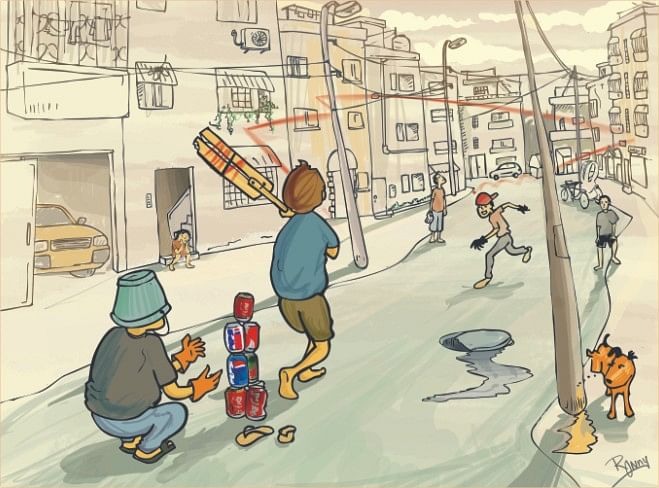 Why we are better than the ICC
Why we are better than the ICC
By Alvi Ahmed and Nayeem Islam
Illustration: ER Ronny
Cricket is just a battle between bat and ball - this definition of the sport is at best an understatement and at worst a ridiculous simplification of a game that's actually too complex to define within one concise sentence. Over the years, the task of defining cricket has been made harder and harder because cricket administrators know the art of procreation all too well to sit back and enjoy just one form of the game.
Test cricket was perhaps invented by men who had no work at all - after all who would toil in the field for five days without any reward at the end in the case of a draw! When interruptions by weather were becoming unbearable for the passionate spectators, the fecundity of the game came to the rescue. And people realised cricket could thrive if newer forms of the game were invented by just decreasing the number of overs played by each side.
Thus one day cricket was born - giving each team 50 overs to bat and ruling out the possibility of a dull draw at the end of 100 overs of cricket. Limited overs cricket filled up the coffers of ICC but ICC responded by increasing the number of games to such an extent that it was tantamount to killing the goose which lays the golden egg.
And in that time too the notion that cricket is a game that people will watch whenever and however it was played changed to cricket is a game that needed to fit into the lives of the people. In came T20 cricket - the streamlined form of the one day game that delivered three and half hours of entertaining cricket sans boredom. In a few years time, even 20 overs a side cricket might be curtailed to something much shorter and more entertaining.
But the ICC's requirement for a large field, wooden ball and other multifarious equipments would have sealed the fate of the game in this concrete jungle we passionately call Dhaka City; but thanks to our imaginative brains cricket flourishes inside the house, garage, on the roof and street albeit with some mishaps like breaking someone's window. Some of our major innovations include:
House cricket: There are two reasons why House cricket (cricket played at home) came into existence. The first one is due to a lack of proper fields and secondly it's not safe for kids to play outside. The most important thing you learn is control. You can't hit the ball too hard; otherwise you may break your mother's Tk 80,000 vase or something. So you learn blocking techniques, which will help you develop into a more technical batsman.
The downsides of this form of cricket are, you can't slog and it mostly helps batsmen learn their craft rather than the bowlers.
Hartal cricket: When life gives you empty streets you play cricket. Now the most important things you can pick up in this form of cricket are the fielding techniques. If you are brave and skillful enough to dive, jump and slide in the streets, then you can do it anywhere. Be careful though, the streets are merciless and you will experience severe cuts and bruises. Plus you can also slog your heart out in this form of cricket. Just make sure you don't break any windows or lose the ball.
Roof cricket: This form of cricket is a bowler's paradise. This is because if the batsman hits the ball out of the roof, he will lose his wicket. So the batsman will think twice before hitting the ball too hard, so the bowlers can get away with a few loose deliveries. The trick is to bowl really fast and generate a lot of bounce, so that as soon as the ball makes contact with the bat it will fly out of the roof. Perfect place to practice bouncers and those Breet Lee-esque fast deliveries.
Garage cricket: Very similar to home cricket, garage cricket can also be used to learn control. Because you don't want to break the windows of your new Mercedes. Garage cricket can also teach batsmen the art of placement. In these forms of “limited space” cricket, finding gaps are extremely difficult. So what you should do is, hit the ball in such a way that it lands right under a car. The fielders will have a tough time retrieving the ball and will give you just enough time for a couple of runs.
One on one cricket: This form of cricket has only two players, a batsman and a bowler. This will test a bowler's real skill because he/she cannot rely on the fielders, and the only way to get the batsman out is to bowl him or pull off a “caught and bowled”. One on one cricket is fun for the batsman because they can hit the ball anywhere they want and not get caught.
As long as international cricket survives, it will only do so because the ICC has been wise enough to tap into the game's potential for procreation into different forms on a regular basis without altering the basic laws of the sport. But by tweaking with the basic laws of the game, replacing wooden balls with tennis or paper balls; we have invented more interesting and challenging versions of cricket and in the process proven that when it comes to innovation, we are simply miles ahead of the ICC!
